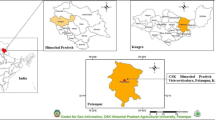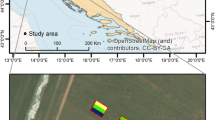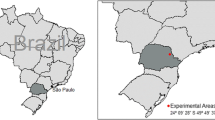Abstract
In recent years, the massive exploitation of agricultural land intended to meet growing food demand has led to a reduction in soil fertility through the depletion of nutrients and organic matter. To implement sustainable agriculture, it is necessary to reduce soil tillage and use residual biomasses that are easily available in the region as soil amendments. Furthermore, it is important to test these residual biomasses in order to exclude a possible increase of heavy metals in soils due to the incorporation of the aforementioned biomasses. The current study aimed to evaluate the effects on soil fertility and health following the application of organic fertilizers combined with different soil tillage practices and the agronomic response of Brassica carinata A. (Braun). The soil tillage treatments consisted of conventional (CT) and minimum tillage (MT), whereas the fertilization treatments were mineral fertilizer (Nmin), municipal solid waste compost (Ncomp), mixed compost and mineral fertilizer (Nmix), and sewage sludge (Nss). These treatments were compared with an unfertilized control (N0). The Ncomp and Nss treatments enhanced soil fertility, increasing the organic carbon and available phosphorus concentrations compared with N0 and Nmin, whereas no significant difference was showed between the soil tillage treatments in terms of soil fertility. In addition, Nss did not show any significant difference compared to Nmin in terms of crop biomass, whereas this parameter appeared higher in CT compared with MT. A principal component analysis showed that the concentrations of toxic elements applied by the organic amendments did not change the dynamic equilibrium of the soil–plant system. Over the short term, the replacement of CT and Nmin with MT and Nss can be achieved, thus guaranteeing the sustainable cultivation of Brassica, without significant changes in heavy metal concentration in soil.


Similar content being viewed by others
References
Acreche MM, Slafer GA (2005) Grain weight response to increases in number of grains in wheat in a Mediterranean area. Field Crop Res 98:52–59. https://doi.org/10.1016/j.fcr.2005.12.005
Alam MK, Islam MM, Salahin N, Hasanuzzaman M (2014) Effect of tillage practices on soil properties and crop productivity in wheat-mungbean-rice cropping system under subtropical climatic conditions. Scientific World Journal 2014:15. https://doi.org/10.1155/2014/437283
Barbera V, Poma I, Gristina L, Novara A, Egli M (2010) Long-term cropping systems and tillage management effects on soil organic carbon stock and steady state level of c sequestration rates in a semiarid environment. Land Degrad Develop 23:82–91. https://doi.org/10.1002/ldr.1055
Bouzerzour H, Tamrabet L, Kribaa M (2002) Response of barley and oat to the wastewater irrigation and to the sludge amendment. In: the proc. Int. seminar: biol. And environ. University Mentouri, Constantine, p 71
Cardone M, Mazzoncini M, Menini S, Rocco V, Senatore A, Seggiani M, Vitolo S (2003) Brassica carinata as an alternative oil crop for the production of biodiesel in Italy: agronomic evaluation, fuel production by transesterification and characterization. Biomass Bioenergy 25:623–636. https://doi.org/10.1016/S0961-9534(03)00058-8
Commission of the European Communities, COM (2005) Biomass action plan, Brussels, 1–46
Debiase G, Montemurro F, Fiore A, Rotolo C, Farrag K, Miccolis A, Brunetti G (2016) Organic amendment and minimum tillage in winter wheat grown in Mediterranean conditions: effects on yield performance, soil fertility and environmental impact. Eur J Agron 75:149–157. https://doi.org/10.1016/j.eja.2015.12.009
Diacono M, Montemurro F (2010) Long-term effects of organic amendments on soil fertility. A review. Agron Sustain Dev 30:401–422. https://doi.org/10.1051/agro/2009040
Ganuza A, Almendros G (2003) Organic carbon storage in soils of the Basque Country (Spain): the effect of climate, vegetation type and edaphic variables. Biol Fert Soils 37:154–162. https://doi.org/10.1007/s00374-003-0579-4
He Z, Yang X, Kahn BA, Stoffella PJ, Calvert DV (2001) Plant nutrition benefits of phosphorus, potassium, calcium, magnesium, and micronutrients from compost utilization. In: Stoffella PJ, Kahn BA (eds) . CRC Press LLC, Compost utilization in horticultural cropping systems, pp 307–317
Jiménez EI, García VP (1989) Evaluation of city refuse compost maturity: a review. Biol Waste 27:115–142. https://doi.org/10.1016/0269-7483(89)90039-6
Jolliffe IT (1986) Choosing a subset of principal components or variables second edition. In: Jolliffe IT (ed). Springer-Verlag, New York, pp 111–147
Jug I, Jug D, Kovačević D, Đurđević B, Stipešević B (2015) Heavy metals concentration in soybean as affected by different tillage systems in Baranja region. UDK 633.34:546.4/.9]:631.51(497.5), pp. 107–112
Legislative Decree 99/1992. Gazzetta Ufficiale 38, Supplemento Ordinario 28, 15 febbraio 1992
Legislative Decree 152/2006. Gazzetta Ufficiale 88, Supplemento Ordinario 96, 14 aprile 2006
Legislative Decree 75/2010. Gazzetta Ufficiale 121, Supplemento Ordinario 106, 26 maggio 2010
Liu H-t, Wang Y-w, Huang W-d, Lei M (2016) Response of wine grape growth, development and the transfer of copper, lead, and cadmium in soil-fruit system to sludge compost amendment. Environ Sci Pollut Res 23:24230–24236. https://doi.org/10.1007/s11356-016-7676-z
Malara A, Oleszczuk P (2013) Application of a battery of biotests for the determination of leachate toxicity to bacteria and invertebrates from sewage sludge-amended soil. Environ Sci Pollut Res 20:3435–3446. https://doi.org/10.1007/s11356-012-1268-3
Mathew RP, Feng Y, Githinji L, Ankumah R, Balkcom KS (2012, 2012) Impact of no-tillage and conventional tillage systems on soil microbial communities. Appl Environ Soil Sci:10. https://doi.org/10.1155/2012/548620
MiPAF (1999) Decreto Ministeriale del 19 aprile 1999 recante “Approvazione del codice di buona pratica agricola”. Gazzetta ufficiale n. 102 S.O. n. 86 del 4 maggio 1999. Ministero per le Politiche Agricole
Mochizuki MJ, Rangarajan A, Bellinder RR (2007) Overcoming compaction limitations on cabbage growth and yield in the transition to reduced tillage. HortScience 42:1690–1694
Osobamiro MT, Adewuyi GO (2015) Levels of heavy metals in the soil: effects of season, agronomic practice and soil geology. J Agr Chem Environ 4:109–117. https://doi.org/10.4236/jacen.2015.44012
Özyazıcı MA (2013) Effects of sewage sludge on the yield of plants in the rotation system of wheat-white head cabbage-tomato. Eurasian J Soil Sci 2:35–44
Page AL, Miller RH, Keeney DR (1982) Methods of Soil Analysis. Part 2 - Chemical and Microbiological Properties, 2nd Edition. Agronomy Society of America, Madison, WI
Ren T, Wang J, Chen Q, Zhang F, Lu S (2014) The effects of manure and nitrogen fertilizer applications on soil organic carbon and nitrogen in a high-input cropping system. PLoS One. https://doi.org/10.1371/journal.pone.0097732
Soil Survey Staff, Keys to Soil Taxonomy, 12th ed. (2014) USDA-Natural Resources Conservation Service, Washington, DC
Sonmez F, Bozkurt MA (2006) Lettuce grown on calcareous soils can benefit from sewage sludge. Acta Agr Scand B-S P 56:17–24. https://doi.org/10.1080/09064710510005813
Weber J, Karczewska A, Drozd J, Licznar M, Licznar S, Jamroz E, Kocowicz A (2007) Agricultural and ecological aspects of a sandy soil as affected by the application of municipal solid waste composts. Soil Biol Biochem 39:1294–1302. https://doi.org/10.1016/j.soilbio.2006.12.005
Wei Y, Liu Y (2005) Effects of sewage sludge compost application on crops and cropland in a 3-year field study. Chemosphere 59:1257–1265. https://doi.org/10.1016/j.chemosphere.2004.11.052
Zhang M, Heaney D, Henriquez B, Solberg E, Bittner ER (2006) A four-year study on influence of biosolids/MSW co-compost application in less productive soils in Alberta: nutrient dynamics. Compost Sci Util 14:68–80. https://doi.org/10.1080/1065657X.2006.10702265
Acknowledgements
The authors acknowledge the Apulia Region for the use of the scientific instrumentation acquired with the RELA-VALBIOR project.
Author information
Authors and Affiliations
Corresponding author
Additional information
Responsible editor: Philippe Garrigues
Rights and permissions
About this article
Cite this article
Debiase, G., Traversa, A., Montemurro, F. et al. Minimum tillage and organic fertilization for the sustainable management of Brassica carinata A. (Braun) in the Mediterranean environment. Environ Sci Pollut Res 25, 33556–33565 (2018). https://doi.org/10.1007/s11356-018-3244-z
Received:
Accepted:
Published:
Issue Date:
DOI: https://doi.org/10.1007/s11356-018-3244-z




